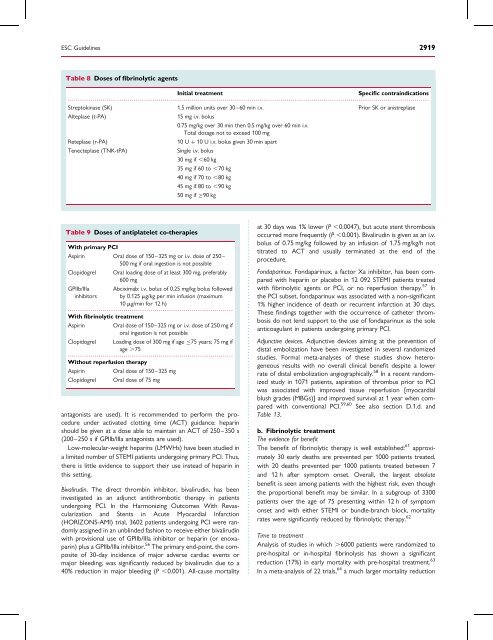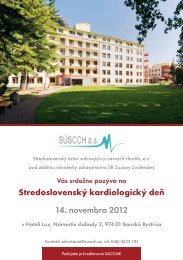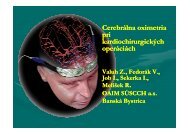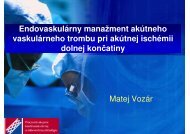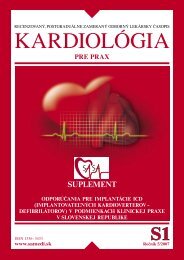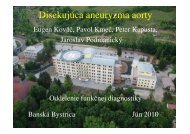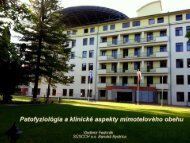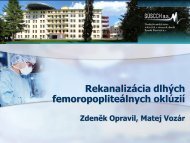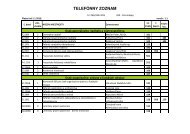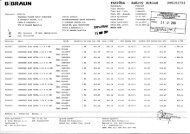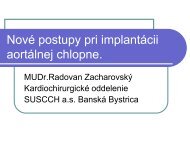Management of acute myocardial infarction in patients presenting ...
Management of acute myocardial infarction in patients presenting ...
Management of acute myocardial infarction in patients presenting ...
Create successful ePaper yourself
Turn your PDF publications into a flip-book with our unique Google optimized e-Paper software.
ESC Guidel<strong>in</strong>es 2919<br />
Table 8 Doses <strong>of</strong> fibr<strong>in</strong>olytic agents<br />
Initial treatment<br />
Specific contra<strong>in</strong>dications<br />
...............................................................................................................................................................................<br />
Streptok<strong>in</strong>ase (SK) 1.5 million units over 30–60 m<strong>in</strong> i.v. Prior SK or anistreplase<br />
Alteplase (t-PA)<br />
15 mg i.v. bolus<br />
0.75 mg/kg over 30 m<strong>in</strong> then 0.5 mg/kg over 60 m<strong>in</strong> i.v.<br />
Total dosage not to exceed 100 mg<br />
Reteplase (r-PA)<br />
10 U þ 10 U i.v. bolus given 30 m<strong>in</strong> apart<br />
Tenecteplase (TNK-tPA)<br />
S<strong>in</strong>gle i.v. bolus<br />
30 mg if ,60 kg<br />
35 mg if 60 to ,70 kg<br />
40 mg if 70 to ,80 kg<br />
45 mg if 80 to ,90 kg<br />
50 mg if 90 kg<br />
Table 9 Doses <strong>of</strong> antiplatelet co-therapies<br />
With primary PCI<br />
Aspir<strong>in</strong> Oral dose <strong>of</strong> 150–325 mg or i.v. dose <strong>of</strong> 250–<br />
500 mg if oral <strong>in</strong>gestion is not possible<br />
Clopidogrel Oral load<strong>in</strong>g dose <strong>of</strong> at least 300 mg, preferably<br />
600 mg<br />
GPIIb/IIIa Abciximab: i.v. bolus <strong>of</strong> 0.25 mg/kg bolus followed<br />
<strong>in</strong>hibitors by 0.125 mg/kg per m<strong>in</strong> <strong>in</strong>fusion (maximum<br />
10 mg/m<strong>in</strong> for 12 h)<br />
................................................................................<br />
With fibr<strong>in</strong>olytic treatment<br />
Aspir<strong>in</strong> Oral dose <strong>of</strong> 150–325 mg or i.v. dose <strong>of</strong> 250 mg if<br />
oral <strong>in</strong>gestion is not possible<br />
Clopidogrel Load<strong>in</strong>g dose <strong>of</strong> 300 mg if age 75 years; 75 mg if<br />
age .75<br />
................................................................................<br />
Without reperfusion therapy<br />
Aspir<strong>in</strong> Oral dose <strong>of</strong> 150–325 mg<br />
Clopidogrel Oral dose <strong>of</strong> 75 mg<br />
antagonists are used). It is recommended to perform the procedure<br />
under activated clott<strong>in</strong>g time (ACT) guidance: hepar<strong>in</strong><br />
should be given at a dose able to ma<strong>in</strong>ta<strong>in</strong> an ACT <strong>of</strong> 250–350 s<br />
(200–250 s if GPIIb/IIIa antagonists are used).<br />
Low-molecular-weight hepar<strong>in</strong>s (LMWHs) have been studied <strong>in</strong><br />
a limited number <strong>of</strong> STEMI <strong>patients</strong> undergo<strong>in</strong>g primary PCI. Thus,<br />
there is little evidence to support their use <strong>in</strong>stead <strong>of</strong> hepar<strong>in</strong> <strong>in</strong><br />
this sett<strong>in</strong>g.<br />
Bivalirud<strong>in</strong>. The direct thromb<strong>in</strong> <strong>in</strong>hibitor, bivalirud<strong>in</strong>, has been<br />
<strong>in</strong>vestigated as an adjunct antithrombotic therapy <strong>in</strong> <strong>patients</strong><br />
undergo<strong>in</strong>g PCI. In the Harmoniz<strong>in</strong>g Outcomes With Revascularization<br />
and Stents <strong>in</strong> Acute Myocardial Infarction<br />
(HORIZONS-AMI) trial, 3602 <strong>patients</strong> undergo<strong>in</strong>g PCI were randomly<br />
assigned <strong>in</strong> an unbl<strong>in</strong>ded fashion to receive either bivalirud<strong>in</strong><br />
with provisional use <strong>of</strong> GPIIb/IIIa <strong>in</strong>hibitor or hepar<strong>in</strong> (or enoxapar<strong>in</strong>)<br />
plus a GPIIb/IIIa <strong>in</strong>hibitor. 56 The primary end-po<strong>in</strong>t, the composite<br />
<strong>of</strong> 30-day <strong>in</strong>cidence <strong>of</strong> major adverse cardiac events or<br />
major bleed<strong>in</strong>g, was significantly reduced by bivalirud<strong>in</strong> due to a<br />
40% reduction <strong>in</strong> major bleed<strong>in</strong>g (P ,0.001). All-cause mortality<br />
at 30 days was 1% lower (P ,0.0047), but <strong>acute</strong> stent thrombosis<br />
occurred more frequently (P ,0.001). Bivalirud<strong>in</strong> is given as an i.v.<br />
bolus <strong>of</strong> 0.75 mg/kg followed by an <strong>in</strong>fusion <strong>of</strong> 1.75 mg/kg/h not<br />
titrated to ACT and usually term<strong>in</strong>ated at the end <strong>of</strong> the<br />
procedure.<br />
Fondapar<strong>in</strong>ux. Fondapar<strong>in</strong>ux, a factor Xa <strong>in</strong>hibitor, has been compared<br />
with hepar<strong>in</strong> or placebo <strong>in</strong> 12 092 STEMI <strong>patients</strong> treated<br />
with fibr<strong>in</strong>olytic agents or PCI, or no reperfusion therapy. 57 In<br />
the PCI subset, fondapar<strong>in</strong>ux was associated with a non-significant<br />
1% higher <strong>in</strong>cidence <strong>of</strong> death or recurrent <strong><strong>in</strong>farction</strong> at 30 days.<br />
These f<strong>in</strong>d<strong>in</strong>gs together with the occurrence <strong>of</strong> catheter thrombosis<br />
do not lend support to the use <strong>of</strong> fondapar<strong>in</strong>ux as the sole<br />
anticoagulant <strong>in</strong> <strong>patients</strong> undergo<strong>in</strong>g primary PCI.<br />
Adjunctive devices. Adjunctive devices aim<strong>in</strong>g at the prevention <strong>of</strong><br />
distal embolization have been <strong>in</strong>vestigated <strong>in</strong> several randomized<br />
studies. Formal meta-analyses <strong>of</strong> these studies show heterogeneous<br />
results with no overall cl<strong>in</strong>ical benefit despite a lower<br />
rate <strong>of</strong> distal embolization angiographically. 58 In a recent randomized<br />
study <strong>in</strong> 1071 <strong>patients</strong>, aspiration <strong>of</strong> thrombus prior to PCI<br />
was associated with improved tissue reperfusion [<strong>myocardial</strong><br />
blush grades (MBGs)] and improved survival at 1 year when compared<br />
with conventional PCI. 59,60 See also section D.1.d. and<br />
Table 13.<br />
b. Fibr<strong>in</strong>olytic treatment<br />
The evidence for benefit<br />
The benefit <strong>of</strong> fibr<strong>in</strong>olytic therapy is well established: 61 approximately<br />
30 early deaths are prevented per 1000 <strong>patients</strong> treated,<br />
with 20 deaths prevented per 1000 <strong>patients</strong> treated between 7<br />
and 12 h after symptom onset. Overall, the largest absolute<br />
benefit is seen among <strong>patients</strong> with the highest risk, even though<br />
the proportional benefit may be similar. In a subgroup <strong>of</strong> 3300<br />
<strong>patients</strong> over the age <strong>of</strong> 75 present<strong>in</strong>g with<strong>in</strong> 12 h <strong>of</strong> symptom<br />
onset and with either STEMI or bundle-branch block, mortality<br />
rates were significantly reduced by fibr<strong>in</strong>olytic therapy. 62<br />
Time to treatment<br />
Analysis <strong>of</strong> studies <strong>in</strong> which .6000 <strong>patients</strong> were randomized to<br />
pre-hospital or <strong>in</strong>-hospital fibr<strong>in</strong>olysis has shown a significant<br />
reduction (17%) <strong>in</strong> early mortality with pre-hospital treatment. 63<br />
In a meta-analysis <strong>of</strong> 22 trials, 64 a much larger mortality reduction


